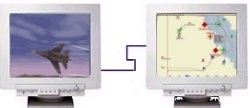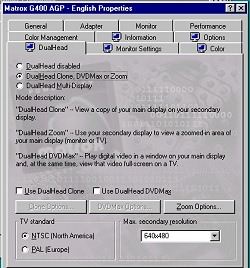| Millennium G400 MAX
by Leonard "Viking1" Hjalmarson |
||||
|
Matrox Graphics is a Canadian company. Many assume that this makes Matrox a small company, but in reality Matrox employ more people than Nvidia. No wonder they keep on popping out with astounding products! After an initial look at the G400 standard version back in June, we've been twiddling our thumbs nervously anticipating the arrival of the high end product, the G400 MAX. There have been various reviews on the Net, but Quake II numbers don't cut it for the simulation crowd. This review will skim over the impressive feature set of the G400 MAX and move on to report frame rate numbers in both Falcon 4 and WW2 Fighters. Prepare to be amazed! More Matrox Marvels Sporting the lowest clock speed of any of the current generation of video accelerator chips, the Matrox G400 is not only faster than the V3 3000 and the TNT2 Ultra, it also runs much cooler! Incredibly, the G400 Series has won a record-setting 61 international print and online awards in the 11 weeks since its May 13, 1999 launch. The core clock is 150MHz, with memory running at a blazing 200MHz. The G400 chip itself is barely warm to the touch, which leads me to wonder if we might later see a MAX+ version as high as 175 MHz. According to Matrox, the peak 3D fill rate of the Millennium G400 MAX is "in excess of 333 Mtexels/sec." I don't want all the technical stuff, take me straight to the benchmarks.) Technical Specs The Millennium G400 MAX sports an integrated AAVID fan and heat sink, probably the best on the market, and comes loaded with 32MB of SGRAM, configured as 4 chips on the front and 4 chips on the back. The SGRAM is manufactured by SEC and rated at 5.5 ns. The G400 standard had only a heat sink and no fan. I won't bore you with the complete listing, which can be found on the Matrox web site. But note the main features: 256-bit DualBus architecture, true 128-bit external bus to video memory, full AGP 2X/4X with Multi-threaded Bus Mastering. Not enough for you? Try Environment Mapped Bump Mapping, Vibrant Color Quality2 (VCQ2) rendering, Matrox DualHead Display Technology, 32-bit Z-buffer including 8-bit stencil buffer, Symmetric Rendering Architecture, 360MHz RAMDAC with UltraSharp RAMDAC technology and full hardware subpicture support for DVD playback. I'll say more about some of these features later. Included software is the Matrox SoftDVD Player, Expendable, and Micrografx Picture Publisher 8 and Simply 3D 3. G400 or G400 MAX The first question to ask is, "What are the main differences between the Millennium G400 and the Millennium G400 MAX?" Matrox doesn't release the actual clock numbers for its products, but an estimate places the speed of the non-MAX product at 115-120MHz. Matrox bills the G400 MAX as 30% faster than the standard product. A 35MHz increase in clock speed would be around 30%, so the numbers seem correct. In the same way, the onboard memory for the standard product is 20% slower, at 6 ns rating. The RAMDAC onboard the G400 converts digital signals into analog ones, which are then interpreted by the monitor. The G400 standard sports a 300MHz RAMDAC. The G400 MAX sports an upscale part, rated at 360MHz, the fastest I've ever tested! A faster RAMDAC allows for higher resolutions, increased color depth and very fast 2D display. New Technology Matrox is one of those innovative companies that prefer to lead the technology race rather than only clone the features of other products. The first of the new features is 256-bit DualBus technology. |
 Dual Head Display Data on the video card is transferred via the video card's bus, simply a path that data follows on the video card. Data normally flows in one direction, like a one-way street or a single lane bridge. The current generation of video cards have 128-bit buses. This means that on any given clock cycle data flows in 128bit width to the graphics chip or to the video memory. Matrox recognized a simple way to maximize data flow by dividing the data path into two one way streets, while maintaining the full width of each path. One 128 bit path goes TO the graphics chip and the other flows FROM the graphics chip. The total bus width is 128x2, or 256-bit, which is why they call it 256-bit DualBus. DualHead: Dual Display Someone at Matrox is into DUAL. Multi-monitor support itself is not a new idea, but until the arrival of the G400 it wasn't used much, at least not at home. But with display prices falling, and full support built into WIN98 and WIN2000, it seems like the future is about to arrive.
 Matrox's DualHead technology differs from traditional multi-monitor support because the second output device can be anything from an additional monitor, a TV, or a flat panel display. Additionally, the second display output can function at an independent refresh rate than the primary display. The result? You no longer have to live with the flicker that results from using a TV as a display device. Large screen TVs suddenly become attractive options! In order to use the second display output, which is a VGA out from the G400 MAX, you must hook up a second monitor or use the adapter provided. The adapter has an S-video out or a composite out. There is a limitation here, however, since the second display does not connect to the 360MHz RAMDAC. Instead, the onboard Cathode Ray Tube Controller manages the second display output via the MGA-TVO chip for analog signals. The second display device is limited to 1024x768 for TV and 1280x1024 for a monitor. Who will use this technology? With DualHead you can have the secondary display running a DVD while edit an article (hint,hint!) Some game developers have taken notice, and Microsoft's Combat Flight Simulator will let the secondary display be used almost any way you like. (In CFS running an additional view window caused a frame rate drop from 38.5 fps to 33 and with an outside view down to 30; PII 500 at 1024x768.) For example, you can have your forward cockpit in one screen, and an enemy view in another. Or use one for an external padlock while you fly forward view in the other. Activision's Star Trek Armada will use the primary display for the bridge while the secondary display is a view of the battlefield. Let's hope that more companies take advantage of this technology. Harpoon4 would be awesome with dual displays! Go to Vibrant Color Quality
|
|||
|
Copyright © 1997 - 2000 COMBATSIM.COM, INC. All Rights Reserved. Last Updated August 14th, 1999 |
||||
